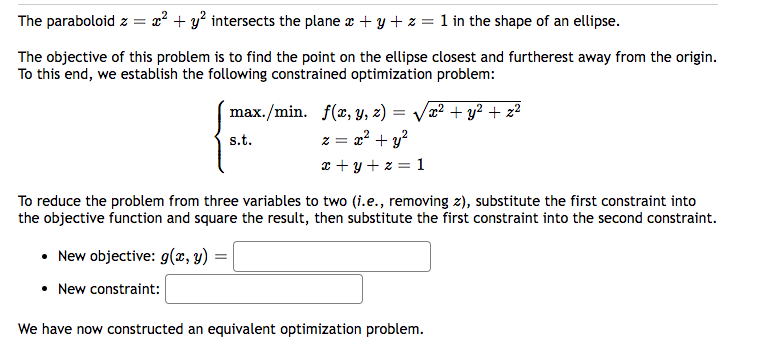The paraboloid z = x² + y² intersects the plane x + y + z = 1 in the shape of an ellipse. The objective of this problem is to find the point on the ellipse closest and furtherest away from the origin. To this end, we establish the following constrained optimization problem: max./min. f(x, y, z) = √√√x² + y² + z² z = x² + y² x+y+z=1 • New objective: g(x, y) • New constraint: s.t. To reduce the problem from three variables to two (i.e., removing z), substitute the first constraint into the objective function and square the result, then substitute the first constraint into the second constraint.
The paraboloid z = x² + y² intersects the plane x + y + z = 1 in the shape of an ellipse. The objective of this problem is to find the point on the ellipse closest and furtherest away from the origin. To this end, we establish the following constrained optimization problem: max./min. f(x, y, z) = √√√x² + y² + z² z = x² + y² x+y+z=1 • New objective: g(x, y) • New constraint: s.t. To reduce the problem from three variables to two (i.e., removing z), substitute the first constraint into the objective function and square the result, then substitute the first constraint into the second constraint.
Linear Algebra: A Modern Introduction
4th Edition
ISBN:9781285463247
Author:David Poole
Publisher:David Poole
Chapter4: Eigenvalues And Eigenvectors
Section4.2: Determinants
Problem 15AEXP
Related questions
Question

Transcribed Image Text:The paraboloid z = x² + y² intersects the plane x + y + z = 1 in the shape of an ellipse.
The objective of this problem is to find the point on the ellipse closest and furtherest away from the origin.
To this end, we establish the following constrained optimization problem:
• New objective: g(x, y)
• New constraint:
max./min. f(x, y, z) = √√x² + y² + z²
z = x² + y²
x+y+z=1
To reduce the problem from three variables to two (i.e., removing z), substitute the first constraint into
the objective function and square the result, then substitute the first constraint into the second constraint.
=
s.t.
We have now constructed an equivalent optimization problem.
Expert Solution
This question has been solved!
Explore an expertly crafted, step-by-step solution for a thorough understanding of key concepts.
Step by step
Solved in 2 steps with 2 images

Recommended textbooks for you

Linear Algebra: A Modern Introduction
Algebra
ISBN:
9781285463247
Author:
David Poole
Publisher:
Cengage Learning

Algebra for College Students
Algebra
ISBN:
9781285195780
Author:
Jerome E. Kaufmann, Karen L. Schwitters
Publisher:
Cengage Learning


Linear Algebra: A Modern Introduction
Algebra
ISBN:
9781285463247
Author:
David Poole
Publisher:
Cengage Learning

Algebra for College Students
Algebra
ISBN:
9781285195780
Author:
Jerome E. Kaufmann, Karen L. Schwitters
Publisher:
Cengage Learning
